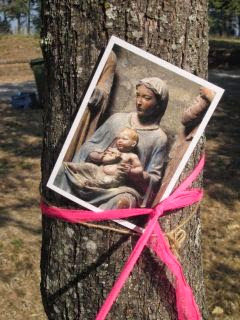The Sad Source
broken water pipe, old pallets and odd bits of rubbish
St. Bernard de Menthon
St. Bernard is incarcerated overlooking an expansive car park high in the middle of nowhere.
St. Bernard de Menthon was born about 1120 in the Chateau de Menthon, near Annency to a wealthy noble family. According to popular legend, Bernard wasn't keen on his arranged marriage, so he fled the family castle on the night before the wedding. During his flight he threw himself from his window and Angels delivered him gently to the ground.
He followed his calling and joined the Church where he rapidly rose in rank due to his virtue and learning. Unhappy about the "pagan ways" in the Alps he devoted himself to converting and performing miracles. However most memorable was his hospice service.
Since ancient times there has been a path across the Pennine Alps leading from the valley of Aosta to Valais. The traditional route of this pass is perpetually covered with 2.5 m of snow and drifts sometimes accumulate to the height of 10m. Although the pass was extremely dangerous, especially with springtime avalanches, it was well used by French and German pilgrims en route to Rome.
Bernard had the charge of caring for the poor and travelers, so around 1050 he founded a canonry and hospice at the highest point of the pass, 4384m, at the site which has come to bear his name. All year, and especially during heavy snowstorms, the canons went out in search of those who might have succumbed to the severity of the weather. They offered food, clothing, and shelter to the unfortunate travelers and took care of the dead. From the 17th century they were accompanied by the common herding dogs of the Valais.
The St. Bernard dog's average weight is between 64–120 kg and is approximately 70 to 90 cm at the shoulder. They are thought to be descendants of molasser dogs brought into the Alps by the early Romans.
The most famous St. Bernard at the pass was Barry, who reportedly saved between 40-100 lives. There is a monument to him at the Cimetiere des Chiens and his body is preserved at the Natural History Museum at Berne.
St. Bernard dogs are still on the site as pets, however now helicopters are used in rescue operations.



















